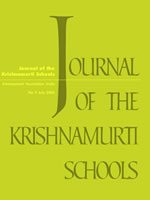Issue 9 - July 2005

- Written by J. Krishnamurti
Just listen to what I am saying because I have got something more to say. Right?
- Written by P. Ramesh
We live our lives (“of quiet desperation”, as Thoreau put it) in the light of opposites – body and soul, violence and non-violence, truth and falsehood, sacred and profane, this world and the next, and so on.
- Written by Suprabha Seshan
After a decade of involvement in nature education with individuals and groups from widely differing socio-cultural milieus, we have noticed that a profound alienation from the natural and the wild has taken place, in all human societies, for various reasons and to varying degrees.
- Written by Stephen Smith
The question is sometimes raised, why the Krishnamurti schools do not have greater purchase in the educational community and, with the exception of the schools of the Rural Education Programme at Rishi Valley, do not have wider applicability.
- Written by Steffi Barna and Lorenzo Castellari
For some years now I have been interested in the potential of physical education (PE) to support inquiry and learning.
- Written by Steffi Barna and Lorenzo Castellari
Castellari’s reflections touch upon many of the ideas I myself have been working on.
- Written by Steffi Barna and Lorenzo Castellari
As teachers in Krishnamurti Schools, we are concerned with enabling self-discovery and awareness.
- Written by Editors
In our ongoing engagement with the daily business of teaching and more generally with education, we come up against the question–what are we doing with our children?
- Written by R. Saraswati
Background of NachiketNachiket is one of the many educational centers of the Krishnamurti Foundation.
- Written by Toon Zweers
In this article I will focus on teaching history in a way that is inspired by the Teachings of Krishnamurti.
- Written by John V. Christianson
To discover anything you must look; and to look, your look must be silent.
- Written by Roopa Devadassan
Class Six was a challenge to all of us who were teaching them: twenty-seven 10-year olds, all extremely energetic and scattered.
- Written by Alok Mathur and Chandrika Mathur
Krishnamurti, the quintessential teacher, offered deep insights and perspectives on the human condition and underlined the urgency of approaching the many problems of life with a new, awakened mind.
- Written by Monica Kochar
Teachers are busy people. Their work demands intense engagement with students, other adults, their subject, ways of communicating it, and much else.
- Written by Marleen Schepers
Teachers of a school are colleagues in a special sense of the word.
- Written by Bill Taylor
At the time, Andy was on a collision course with staff and in danger of being asked to leave Brockwood.
- Written by Students
The Post School Programme, located at the Bangalore Education Centre of KFI, is an attempt to extend these concerns of the Krishnamurti Schools to high school graduates and other young adults.
- Written by Patrick Foster
Two things that are very important in the Krishnamurti movement are the ‘Sacred’ and the ‘Teachings’ (how to get to the sacred).
- Written by Shashidhar Jagadeeshan
Prologue The average teacher or for that matter researcher of mathematics rarely bothers herself with the philosophy or epistemology of mathematics.
- Written by Editors
This book is a significant contribution to the growing literature on education, particularly school education, and it is written by an Assistant Professor at the Centre for the Study of Social Systems, Jawaharlal Nehru University, New Delhi.
- Written by Editors
Magical Parent, Magical Child, plays with many ways of getting its message across.

